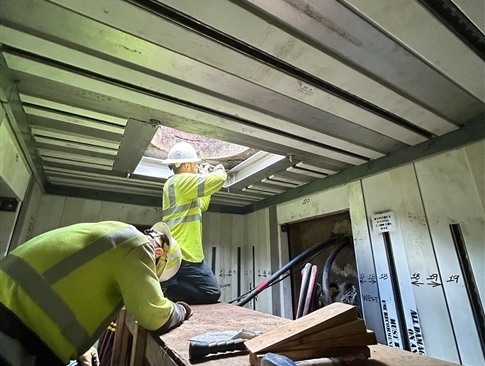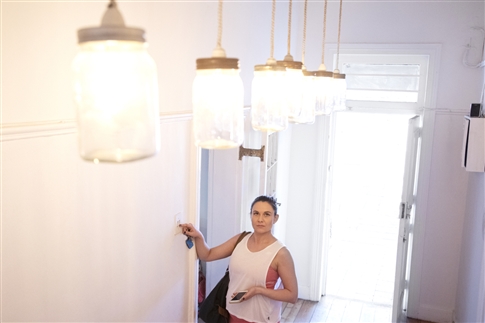Related News
Related News
-
Sustainability Snapshot - Celebrating Energy Efficiency Projects in the Community
Sustainability Snapshops highlight impactful projects completed by EWEB's Customer Solutions department, as a way to celebrate the meaningful work happening behind the scenes.
Find Out More -
EWEB secures $2.5 billion of reliable, affordable, carbon-free energy for customers
The new contract with EWEB’s largest energy supplier, the Bonneville Power Administration, forms the foundation of a diverse energy portfolio.
Find Out More -
Women in STEM: Meet the Hydro Project Engineer Building Habitat for Salmon
EWEB Engineer Associate Val Chang found her way to the McKenzie River from Los Angeles, inspired by heritage trips to the waters of Taiwan and key mentors along the way.
Find Out More -
Public Power Week Poster Contest Winners 2025
The results are in! View the winning posters from EWEB's 2025 Public Power Week Poster Contest.
Find Out More -
EWEB Hometown Heroes compete internationally
Out of 290 teams from 14 different countries, EWEB's Lineman Rodeo team places in the top third of competitors.
Find Out More -
Vote for your favorite Public Power Week Posters
The top five submittals will receive awards. Help us pick the winners.
Find Out More -
Electric Projects underway in North & South Eugene
Underground lines and disaster-resilient power poles are part of EWEB’s infrastructure upgrade near Eugene’s largest natural resource area.
Find Out More -
The Bonneville Power Administration Rate Change and Your EWEB Bill
BPA’s finalized rate increase is smaller than projected, and EWEB’s pass-through adjustment effective October 1, 2025 will now be 2.7% for residential customers—down from the anticipated 4%.
Find Out More -
EWEB completes helicopter installation of salmon habitat features
EWEB adds downed trees and 2,000 tons of gravel to the Uupper McKenzie River below Tamolitch Falls to improve spawning habitat.
Find Out More -
Court rules in favor of EWEB in Carmen-Smith litigation
The U.S. District Court in Eugene has granted EWEB's motion to dismiss a lawsuit brought under the Endangered Species Act pertaining to fish passage at EWEB’s Trail Bridge Dam. The favorable ruling clears the way for EWEB to continue advancing towards implementation of permanent fish passage at the dam.
Find Out More -
EWEB proposes modified plan for permanent fish passage at Trail Bridge Dam
After eight months of extensive collaboration and analysis with scientific experts at two federal regulatory agencies, EWEB is proposing an improved plan to build permanent fish passage facilities at Trail Bridge Dam on the McKenzie River.
Find Out More -
Sustainability Snapshot - Ideal Steel July 2025
Our second Sustainability Snapshop highlights a project where EWEB helped a local industrial warehouse upgrade over 1,000 flourescent lights to new efficient LEDs.
Find Out More -
EWEB prepares for wildfire season with risk mitigation measures
EWEB is building a more resilient electric system to weather various types of disasters, from wildfire to winter storms.
Find Out More -
EWEB, Lane County host open house to gather feedback for “Leaburg Transportation Alternatives Analysis”
“What is the Future of the Leaburg Dam Bridge?” open house exhibit on display at Lloyd Knox Park Visitor Pavilion through July 25
Find Out More -
Improving habitat resiliency throughout the Upper McKenzie
Environmental Responsibility is a core guiding value for EWEB decision-making. This summer, EWEB continues its commitment to environmental stewardship with a robust slate of habitat enhancement updates throughout the upper McKenzie River, across the footprint of the Carmen-Smith Hydroelectric Project.
Find Out More - Show More
Upgrades to Eugene's downtown electric network continue
April 18, 2024 • Robyn Smith, EWEB Communications

Have you ever wondered what’s underground in downtown Eugene? While we can’t speak for everything that’s down below, we can tell you a little about EWEB’s intricate downtown electrical network, which is connected by a series of vaults beneath the city’s streets.
Underground electric cables deliver power to downtown Eugene businesses and homes. A cable vault is typically 8 feet by 13 feet across and 9 feet high and made of concrete, rebar, and steel I-beams. The vaults allow access to the underground cable system for repairs and routine maintenance, and they’re typically beneath the road, at every intersection and mid-block in downtown’s core.

Picture the inside of a downtown electric vault before the installation of the new structure.
You may have noticed construction this week on the corner of 7th and Pearl Street. Crews replaced a corroded, aging vault with an innovative, new Voltek vault. The Voltek design allows for the new infrastructure to be built inside the existing aging vault. We’re able to install the new vault while the cables are still energized, minimizing disruption to customers and traffic while cutting construction time in half.

This is a picture of the installation of the Voltek vault. The new structure is designed to be built inside the older infrastructure, saving time and expense.
Traditional vault replacement would require de-energizing the power supply and road excavation, but EWEB was able to avoid those constraints with the Voltek installation. This method is also a fraction of the cost of a traditional vault replacement. This new infrastructure will provide reliable and safe access to the underground cable network for the next 50 years and beyond.

Picture of rusty high beams that have been removed from the vaults and replaced with stainless steel beams, which will not rust.
Several of these vaults were installed last year in the downtown network and at least one more is scheduled for replacement this year. The vault replacements are a part of EWEB’s major infrastructure investments through our Capital Improvement Plan for rehabilitating, replacing, and installing new infrastructure.
Related Programs
The rebuild effort has begun with the Currin Substation, which is located near Garden Way and Interstate 105.



